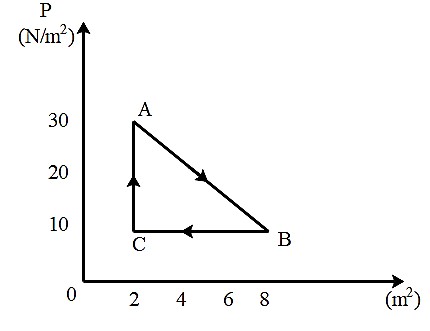
A gas undergoes the cyclic process shown in figure. The cycle is repeated 100 times per minute. The power generated is:

(A)$240W$
(B)$100W$
(C)$60W$
(D)$120W$

Answer
472.8k+ views
Hint: This question is given from chapter law of thermodynamics. Here, we will first see whether the work done by the gas is positive or negative depending on the direction of movement of gas. As we know that the work done by the gas is the area of the curve so we will calculate the area of the P-V curve. Now, we know that the expression for power is the ratio of the work done to the time taken. In this way, we will find the power generated.
Complete step by step answer:
As we all know that work done is equal to the area under the curve so,
$\left| w \right|\,=Area\,under\,the\,curve$
Now, as gas moves in clockwise direction so, work done will be positive i.e.
$w>0$
So, calculating work done –
$\begin {align}
& w=\dfrac {1} {2}\times \left (30-10 \right)\left (8-2 \right) \\
& \Rightarrow w=\dfrac {1} {2}\times 20\times 6 \\
& \Rightarrow w=60J \\
\end{align}$
As mentioned in the question that the cycle is repeated 100 times, so work done will be –
$\begin {align}
& w=60\times 100 \\
& \Rightarrow w=6000J \\
\end{align}$
Now, we will calculate power generated and for this we required work done and time taken,
$\begin {align}
& Power=\frac {Work\, Done} {Time\, Taken} \\
& \Rightarrow Power=\frac {6000} {60} \\
& \therefore Power=100W \\
\end{align}$
So, the correct answer is “Option B”.
Note: We can solve this question by another method also i.e. by dividing the curve into 3 states and the calculating work done by each state and then, summing up the work done by all three states gives the total work done by the gas. Then, dividing the total work done by the time taken gives the value of power generated. After this by analyzing the direction of gas we can calculate whether the work done is positive or negative.
Complete step by step answer:
As we all know that work done is equal to the area under the curve so,
$\left| w \right|\,=Area\,under\,the\,curve$
Now, as gas moves in clockwise direction so, work done will be positive i.e.
$w>0$
So, calculating work done –
$\begin {align}
& w=\dfrac {1} {2}\times \left (30-10 \right)\left (8-2 \right) \\
& \Rightarrow w=\dfrac {1} {2}\times 20\times 6 \\
& \Rightarrow w=60J \\
\end{align}$
As mentioned in the question that the cycle is repeated 100 times, so work done will be –
$\begin {align}
& w=60\times 100 \\
& \Rightarrow w=6000J \\
\end{align}$
Now, we will calculate power generated and for this we required work done and time taken,
$\begin {align}
& Power=\frac {Work\, Done} {Time\, Taken} \\
& \Rightarrow Power=\frac {6000} {60} \\
& \therefore Power=100W \\
\end{align}$
So, the correct answer is “Option B”.
Note: We can solve this question by another method also i.e. by dividing the curve into 3 states and the calculating work done by each state and then, summing up the work done by all three states gives the total work done by the gas. Then, dividing the total work done by the time taken gives the value of power generated. After this by analyzing the direction of gas we can calculate whether the work done is positive or negative.
Recently Updated Pages
NCERT Solutions For Class 4 English Marigold (Poem) - Don’t Be Afraid Of The Dark

NCERT Solutions For Class 5 English Marigold (Poem) - Class Discussion

NCERT Solutions For Class 5 English Marigold - Gullivers Travels

NCERT Solutions For Class 5 Hindi Rimjhim - Bagh Aaya Uss Raat

NCERT Solutions For Class 8 Hindi Bharat Ki Khoj - Tanaav

NCERT Solutions For Class 12 Maths - Differential Equations

Trending doubts
1 ton equals to A 100 kg B 1000 kg C 10 kg D 10000 class 11 physics CBSE

Difference Between Prokaryotic Cells and Eukaryotic Cells

One Metric ton is equal to kg A 10000 B 1000 C 100 class 11 physics CBSE

1 Quintal is equal to a 110 kg b 10 kg c 100kg d 1000 class 11 physics CBSE

Proton was discovered by A Thomson B Rutherford C Chadwick class 11 chemistry CBSE

Draw a diagram of nephron and explain its structur class 11 biology CBSE




